The martial arts is steeped in traditional gender biases.
Sara Lai here tells her experience of being a female lion dancer. Thank you for sharing, Sara.
The martial arts is steeped in traditional gender biases.
Sara Lai here tells her experience of being a female lion dancer. Thank you for sharing, Sara.
No, I am not a lion dance addict. In fact, I haven’t lion danced at all this season! But if you want to know a lion dance addict, meet Andy Ta from Long Beach, California.

Andy Ta
He dreams about lion dance, lion dances for breakfast, lunch and dinner, lion dances on the toilet, lion dances while brushing his teeth, and even lion dances!
Anyway, the real reason for this blog was to promote a video he directed for his class. The narrator in the video is Nathan Phuong, who only recently started learning lion dance last May with Andy. When I met him earlier in January during my trip to SoCal, he was already a great lion dancer full of dedication and enthusiasm. Enjoy!
During this past winter break, I’ve finally decided to name the frame I built from scratch Project T7. Why T7? I can’t tell you yet! Maybe it has to do with the 7th thoracic vertebrae. 😉
Originally, I was planning to put five layers of paper on Project T7, but after the fourth layer, I decided there was a good balance between weight and durability. With one layer of cloth, two layers of grass paper, and two layers of rice paper, Project T7 should withstand everyday performances.
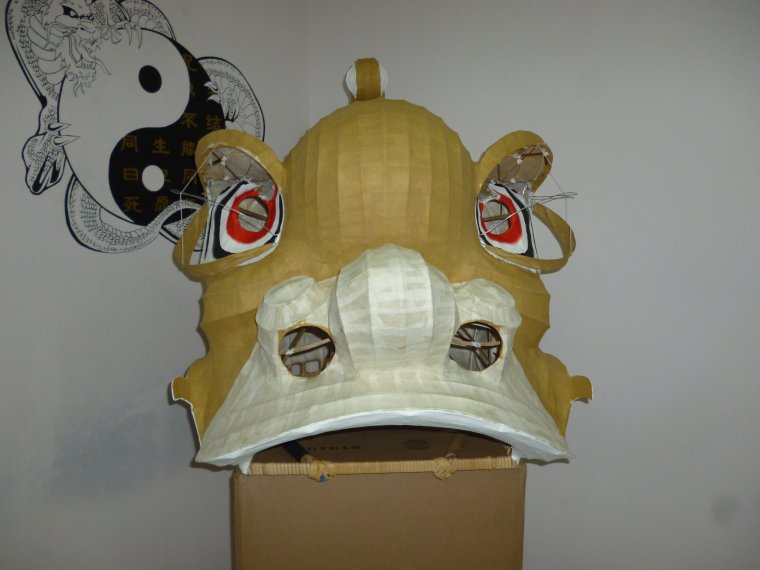
Project T7
There were only a few days of winter break left so I was able to paint the eyes. Blending black paint with other colors is still really hard for me! Black paint always overpowers other colors so I have to be really careful with the amount I use. Anyway, there’s one inner ring of red to represent the overall color theme. It may seem bland now, but I’m conceptualizing something cool for the eyes (or at least I hope it’s cool).
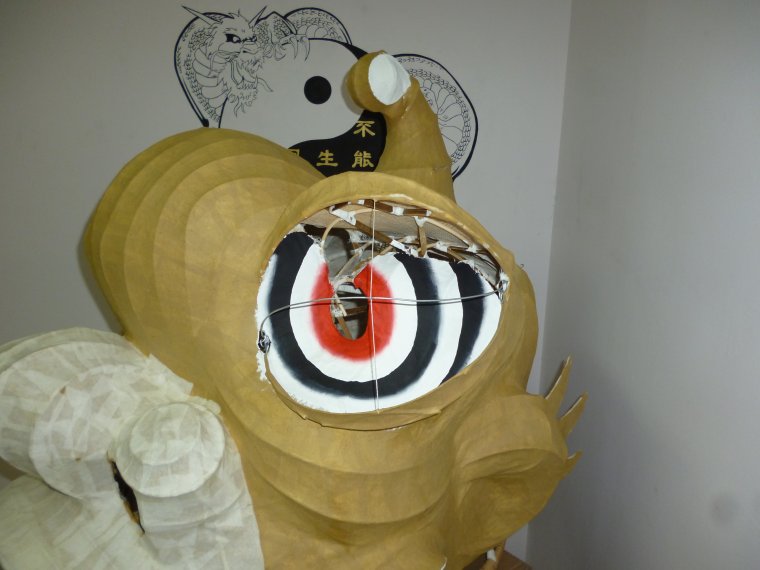
Project T7’s eyes
No one remembers about Project Blossom, but here is its current state.

Project Blossom
Together, Project T7 and Project Blossom make up the Lion Brothers Project.

Lion Brothers Project – Project Blossom and Project T7
I hope to get a significant portion of the painting done during my next break. More updates to come in April!
When I first heard about UCLA’s ACA Lion Dance in 2011, I almost squealed with joy. A lion dance team at the school I was going to! How exciting is that? Unfortunately, the first academic quarter was way too hectic for me to check out their practices. After settling in though, I got the chance to do so.
The team was formed in the early 2000’s by four people. Of these four people, I know one personally and the other is the brother of one of my friends. There are actually some pretty complicated connections between this team and a few other teams, which influences the structure of the practices.
Practices take place in an underground parking garage on campus. Many people come early to relax and chat with others. Once a good number of students show up, the coordinators scream “Rows and Columns!†which signals for everyone to line up. Another scream of “Ready, hut!†and every member is doing the standardized team salute.

Relaxing and chatting.

Doing the standardized team salute.
Immediately after, the team warms up with jumping jacks and stretches.

Warming up with jumping jacks.

Stretching.
Occasionally, a parking enforcement officer may decide to drive his truck into the garage and induce some paranoia amongst people.

Paranoia ensues.
After the stretching, a series of low, medium, and high horse stances are practiced. Both arms are extended in front while a flicking motion is done by the wrist.
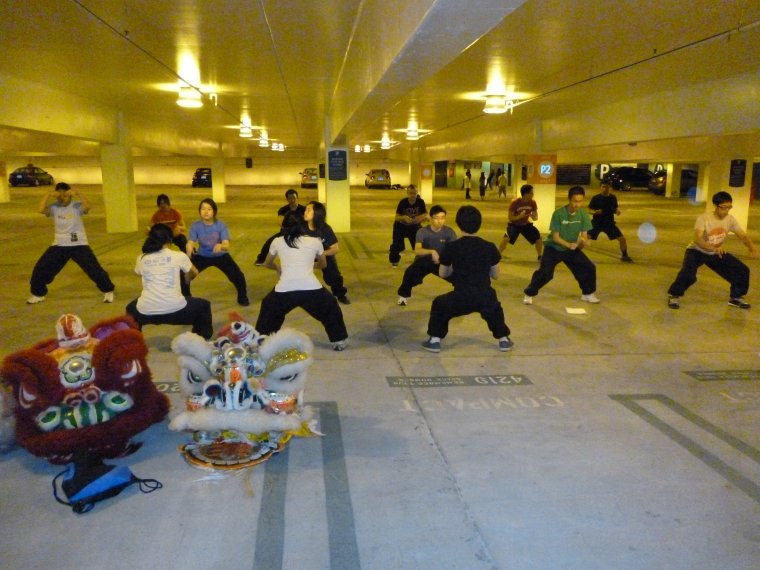
Practicing horse stance.
Afterwards, a semicircle is formed for drumming and cymbaling practice. I’ve never seen them bring a gong though, which makes me wonder if they ever use one. In fact, I wonder if they even have one anymore.

Practicing drumming and cymbaling.
The team utilizes both Fut San and Hok San drumming with an added twist. Many members clap their hands as a substitute for using cymbals. This is actually a good way to practice, since cymbal clashing can get significantly louder than the drum, especially when there are a large number of cymbals.
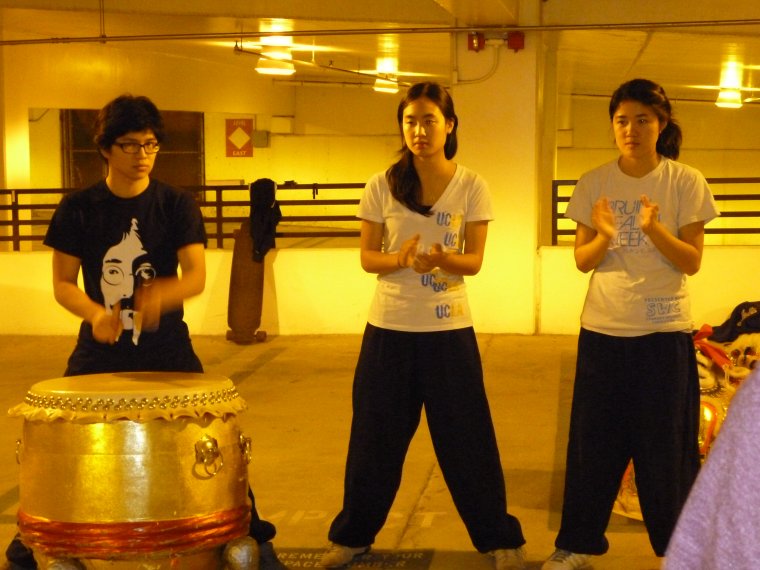
The team coordinators leading practice.
After drumming and cymbaling is the fun stuff! Woot woot! Usually, the team breaks up into two groups – newbies and veterans. The coordinators then split up to supervise each group. Lion movements are practiced for the remainder of the class.
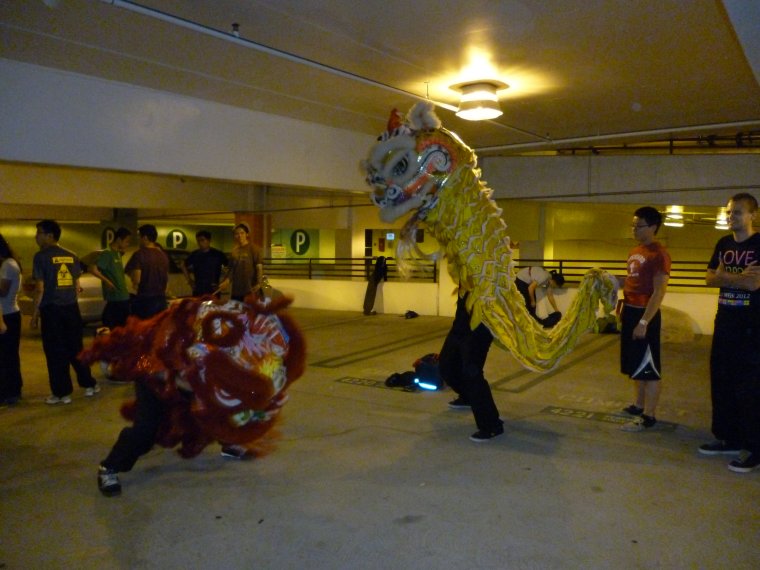
Action!
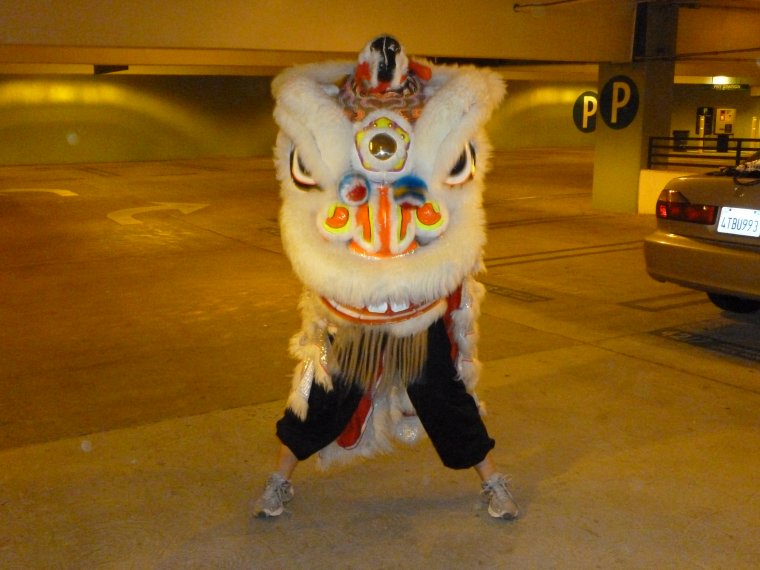
Pose!

Practicing basic movements.

Andy and Steven practicing stunts.
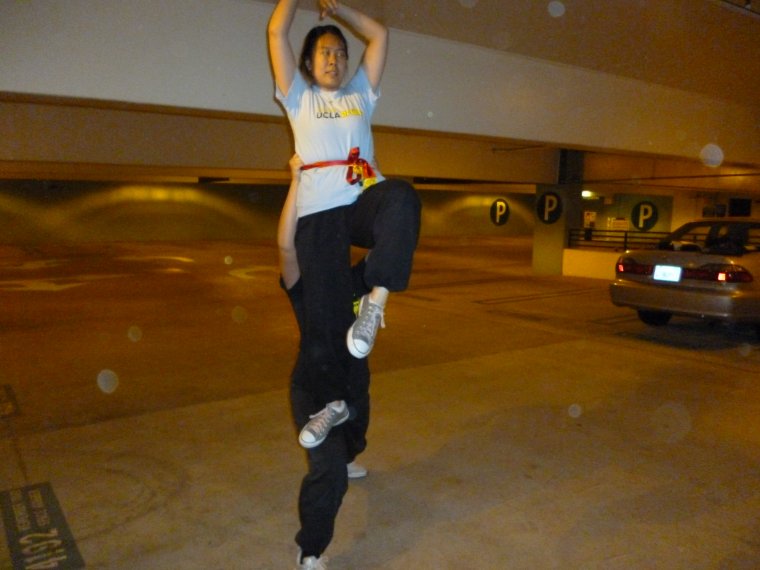
Ashley and Leo practicing a single leg stack.

James and Steven practicing the dip.
UCLA ACA Lion Dance. RAWR!
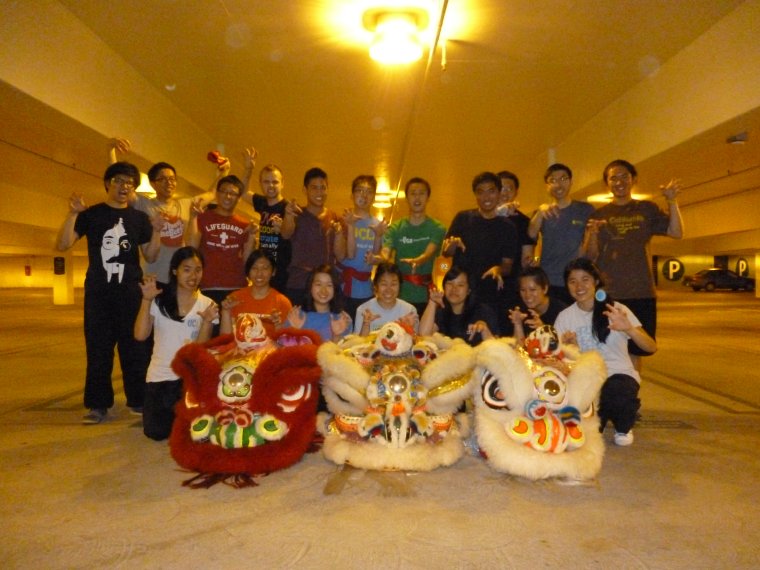
A little over a month ago, I traveled over 300 miles down south to Los Angeles for school. This was pretty much a brand new start for me – it is the first time I’ve ever lived on my own. The first month has been an experimental period, since I needed to find a balance between school and the basic necessities of life. Finding a new lifestyle pattern has kept me out of the lion dance loop for a long time. Being over 300 miles away from my lion dance groups at home, I needed to find a lion dance group in/near Los Angeles.
I must thank Lion Blogs for helping me out on this one. Without much effort from me, I think I’ve found the right lion dance group for me – the Immortals Lion Dance Team based in Monterey Park.
It all started with the blog post about my ignorance in Hok San lion dancing. Chris Low, who commented on the post, introduced me to Yogi Tam through email. Because Yogi came from a Jow Ga background in the East Coast, he knows traditional Hok San lion dancing. It just so happens that both Chris Low and Yogi Tam are in the Los Angeles area, so we planned to meet up one day. Yogi helps teach at the Immortals practices and invited me to check it out. I finally had a bit of free time this Friday, so I went to Monterey Park to check it out.
The first half of practice took place at Jeff Chan’s house, who is the founder of the team. Upon arriving, I was greeted by Yogi and Jeff Chan’s son, Vincent Chan. Probably one of the first things that I noticed was the MASSIVE inventory of lion dance equipment. Vincent showed me a lot of the lion heads that they owned, while simultaneously conversing about Luo An lions. We both agreed that they’re really nice traditional lions and it’s quite unfortunate that the company has shut down after retirement.

A small fraction of their lion dance equipment.

A variety of different masks, some of which I've never seen before!

More lion dance equipment.

Another collection of the more traditional Dai Tau Fut and other characters' masks.
One item that really caught my attention was a dragon head that Jeff Chan customized himself. He used one of Vincent’s childhood lions and transformed it into a dragon head. It was quite an impressive piece of artwork, showcasing extreme creativity.

Lion transformed into a dragon.
While I was talking to Vincent, a group of younger kids were practicing dragon dancing in the front yard. I believe there was one college student, but the majority of the kids were middle school students.
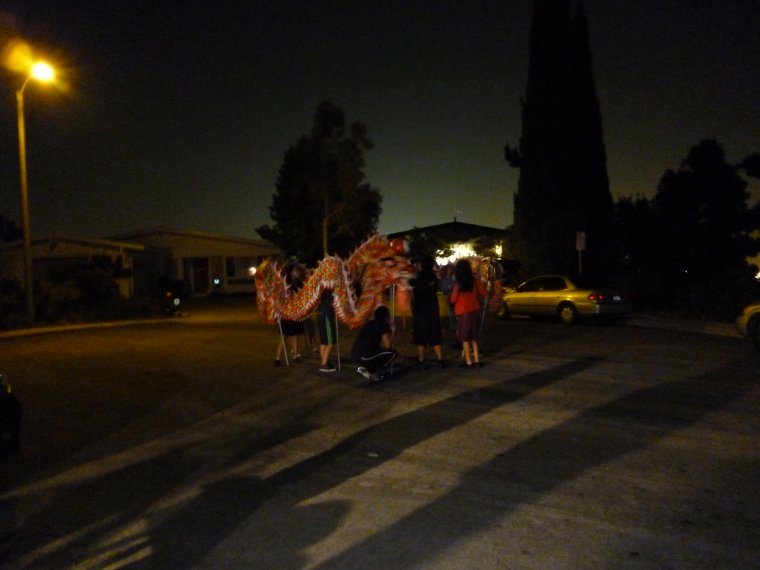
Dragon dancing practice.
After watching some dragon dancing practice, it was time to head over to an elementary school for the second half of practice. During this time, I noticed several things that stood out about this lion dance team – respect, discipline, and love. Before heading over to the elementary school, Vincent told all the kids to line up and introduce themselves to me. I was quite shocked that all of them did so with respect and courtesy. It’s quite rare to find middle school kids with such discipline nowadays. After the formalities, we all hopped into several vehicles headed for the elementary school. I sat in Vincent’s truck, with several middle school girls in the back seats. While driving, he asked the girls about their progress in school. Of all the teams I’ve been with, this was the first time I’ve heard that question being asked. The team has a genuine love for their students. Also, throughout my visit, I felt that Vincent was already treating me like a family member, even though I’ve only met him for several hours. My heart was truly warmed by this, especially due to the nonexistence of relatives in the Los Angeles area.
At the elementary school, there were more kids that showed up. After a brief warm-up session, everyone was split into different groups for different lessons. Being completely out of shape, I was dead tired by the end of practice. Hopefully, I will get back in shape soon.
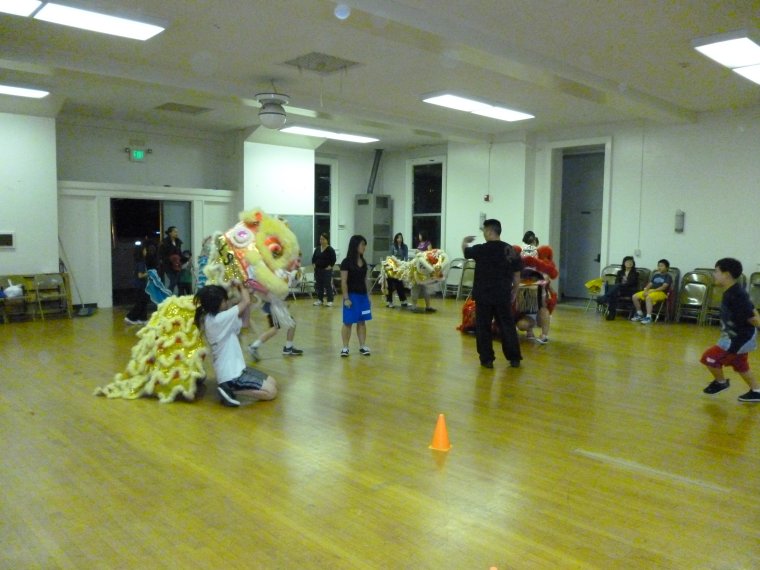
Second part of practice at the elementary school.
I must give my thanks to the Immortals Lion Dance Team, especially Vincent Chan and Yogi Tam.
Check out their website at http://www.immortalsliondance.com.
After reading some comments about The Lion Horse, I’ve come to a realization that I completely neglected the existence of traditional Hok San lion dancing. This was very stupid of me because traditional Hok San lion dancing is probably the closest cousin to traditional Fut San lion dancing, as compared to northern lion dancing, Qilin dancing, etc.  I should have mentioned that I was speaking solely from a Fut San hybrid point of view. Here’s a list of the possible reasons for this ignorance:

Picture taken from http://ykmusa.com/picsperf1.html
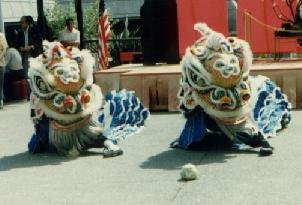
Picture taken from http://ykmusa.com/picsperf1.html
Now that I’ve realized my ignorance in traditional Hok San lion dancing, I really want to learn more. It’s quite unfortunate that I can’t find much information about it on the internet. I think it’s time for me to ask some older and more experienced lion dancers about this topic.
Following a quite nagging and painful Achilles injury from running, I felt it was best to not further aggravate it with wushu. I have been doing more running and have set a goal of running the San Francisco Half Marathon in July.
I go for longer runs on Saturdays and have been using Sundays (normal wushu day) as a rest day. Further, since earlier this year, I have been going on longer runs on Thursday evenings as well and thus have been also missing Thursday’s wushu class. This past month has probably been one of my least wushu involved months in years. With that in mind, I have started to de-prioritize wushu.
I will continue to focus on running for the time being. When Ryan returns to wushu practice, I will make the effort to go and hopefully get in some lion dance practicing.
Sorry for the hiatus folks! School has been draining me for the past month and will continue to do so for the next month! I will be back at the end of May. My sincere apologies.

Are there such things as practice lions, that are made for practicing lion dancing? How does a lion become a “practice” lion? I’ve been wondering about this for some time.
As you can see from our training videos, we usually just practice a bunch of stacking. There are just a few videos where we actually practice with with Ryan’s lion. This is because there’s not really a practice lion to use. So we’re lucky when Ryan has the time and is able to transport his lion to practice.
I ask Ryan about his all the time. He says that basically there are new lions, which are performance lions. These are new and beautiful and people don’t like to get them beaten up by practicing with them. Then, as these performance lions get worn down over the course of their performance lives, they gain sentimental value with the owner/dancer. If something breaks, it is fixed. Over time, the lion may even be put through a restoration process if things get bad. Because they have sentimental value and memories attached to them, they are not sold when they are old, get worn down, or after restoration. They are retired and stashed away as a keepsake.
I guess the only time people get to practice with actual lions is when someone is generous enough to let you use their lion to practice with or if you happen to find an old lion for sale, which I hear is rare. Or maybe you can try to make one to practice with? Either that or you bite the bullet yourself and get a new lion to practice with. Or perhaps, you go with the laundry basket or chair method for practicing lion dancing.
I mean, dragon boaters don’t practice in the bath tub and then get into a real boat on race day. So how do you people do it? I think the answer here, as with most things, comes down to money. You pay for a lion to practice with.
So I’m wondering if there are lions made out there that are are made specifically for practice purposes. No need for paint, fur, or decorations. As long as the mouth and eyes work and the weight is right, it’d be a good practice lion. Or maybe there are lions made that have imperfections. You know, like the Belly Flops of lion dance lions. Or perhaps the poorly manufactured ones that are more affordable? Where do you get those? Anybody know?
This is the room where it all started.
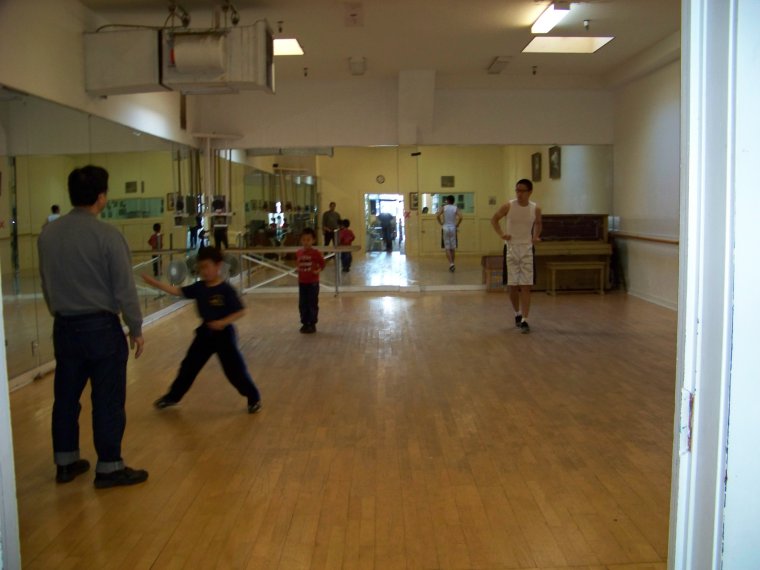
I was only 9 years old when I first walked into this room to learn kung fu and lion dancing. Although the class wasn’t very strict, I still stayed to learn as much as I could. The level of discipline in the class was shown very clearly; I wasn’t a very good martial artist or lion dancer by the time I left 5 years later. Yes, I did learn quite a bit (over 10 forms), but I could not execute them well. Furthermore, within a year of leaving, I forgot 90% of the forms that took me a gruesome 5 years to learn.
Two days ago, I paid a visit to my first Sifu and Simo. The kung fu class has changed drastically. In fact, they don’t even do lion dancing anymore. In order to focus on teamwork, my Sifu bought a baby dragon set, which utilizes a group of 8 adolescents. The class has also become smaller in size, which gives a chance for my Sifu to help students individually. The quality and discipline of the class has gotten much better, but can still go for some improvement.
Memories rushed through my brain as I stood at the doorway watching my Sifu teach the students. His teaching style is very relaxed, yet thorough. In my opinion, it would be much better for him to teach older teenagers and young adults rather than adolescents. Still, you can see the joy in his eyes as he teaches the kids. I still remember the times he would walk up to me to give me individual feedback as I did my forms. Oh, how I miss those days. My interests in kung fu and lion dancing has definitely stemmed from the experiences I’ve had in that room.
The excitement surged through my body as I carried my first brand new lion head out of Clarion Music Center. I wasn’t the only one affected by these feelings; my Si Hing had also purchased a lion head on the same day, at the same time. We both walked out of the shop with pride.
Just the other day, I was digging through my old lion dance pictures to reminisce my past experiences in the art. Although the purchase was hasty, I do not regret buying my first lion. I’m sure my Si Hing feels the same way too. Speaking of my Si Hing, we had a pretty interesting history together. He was one year older than me, and went to the same elementary and middle school as me. Even then, I had no idea who he was until I joined my first kung fu class, where he was notoriously known as the mischievous Si Hing. We quickly became friends.
After several years of practicing together, we decided it was time to buy our own lion heads. Heck, we probably thought we were bad@$$ lion dancers at the time, but in reality, we sucked. It was literally a lion DANCE. No power, no stances, no nothing. Just two kids waving a paper mache mask around. We simply didn’t have the enthusiasm that real lion dancers had; we just wanted to enjoy ourselves.
The Hoi Gong ceremony for the two lion heads were done on the same day, during my Sifu’s annual birthday celebration performance. In addition, both lions were dotted by my Sifu. Automatically, we knew that these two lions would be lion brothers forever.
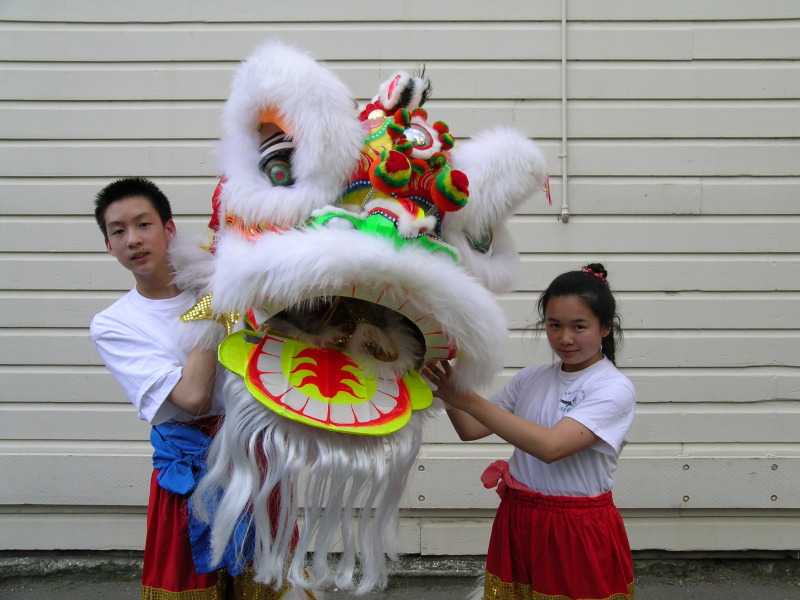
My Si Hing and his lion dance partner holding up his brand new lion.

Me and my lion dance partner holding up my brand new lion.
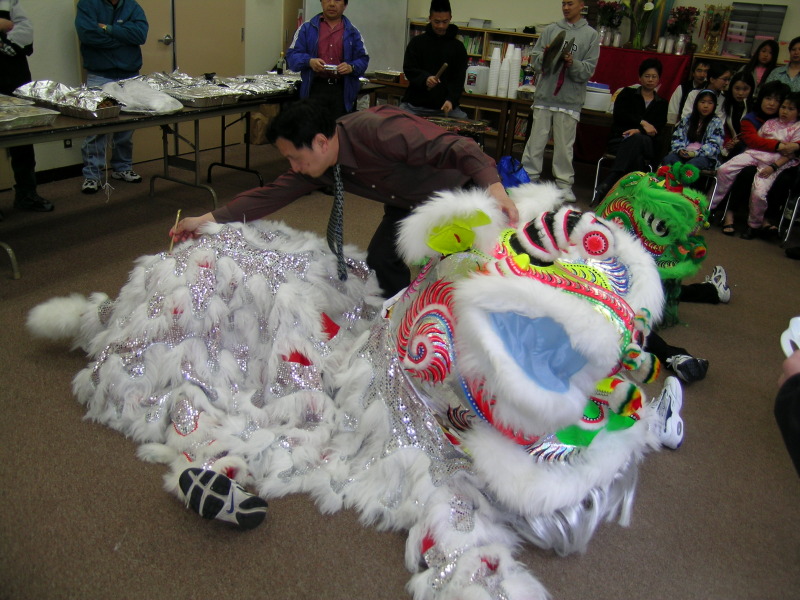
My Sifu going through the Hoi Gong ceremony with my lion.

My Si Hing doing the sleeping/waking up routine.

The lion brothers in their first performance.
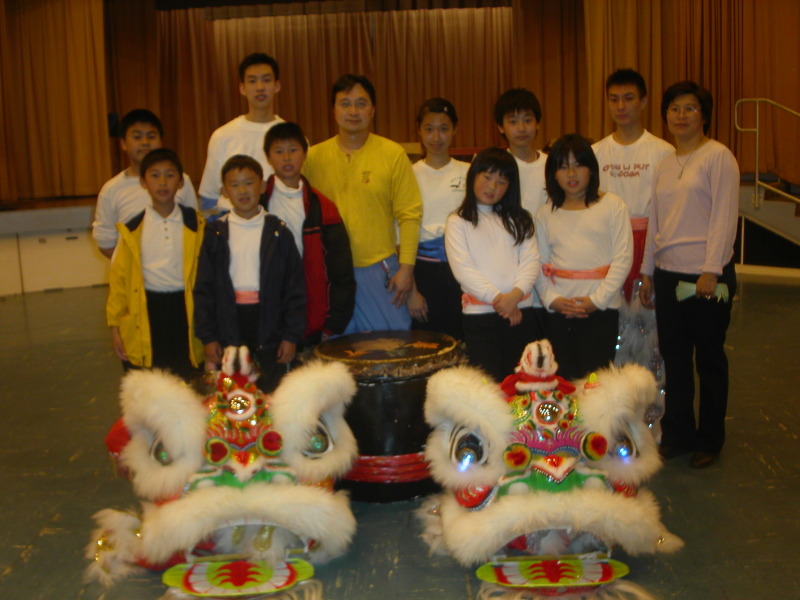
Group picture featuring the lion brothers.
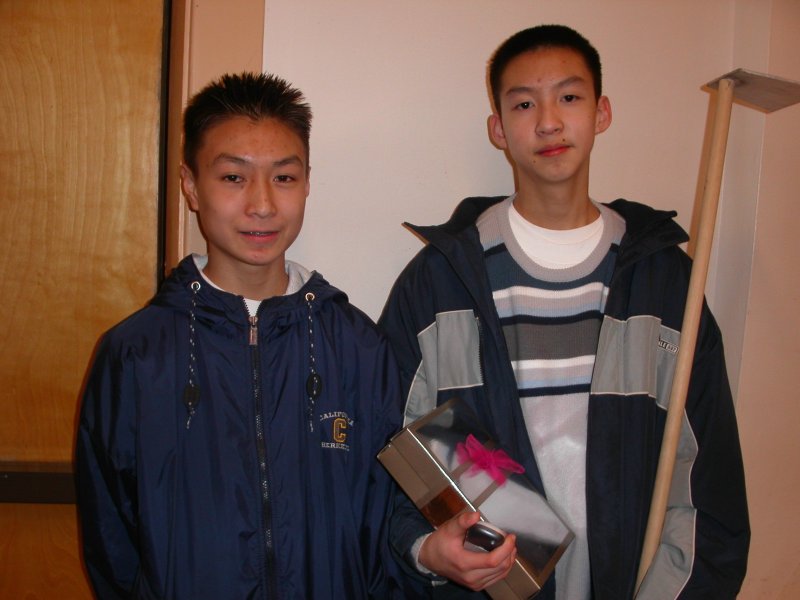
Circa 2004 – My Si Hing and me.

Ryan brought his lion to practice today. Ryan has been absent from practice for some time due to his school work load.
Ryan showed some of the wushu youth how to hold the lion, shoot the lion’s head, and some stance positions. I think the youth are interested in learning more. Heck, lion dancing is fun and is a change from the usual wushu basics that we do every time.
We worked on a few new things today. We worked on the intro of picking up and getting under the lion. We never really do this at performances because we usually always enter the audience area already underneath the lion. But this is good to know, in case we do a different intro where we’re outside the lion to begin with.
The intro we devised is simple, has a salute, a few empty hand movements, including a jump inside. Then we skip over the lion and pick it up. The head pick up involves a lift with the foot, which is pretty neat. We’ll need to practice this more.
The second new thing we tried today was a body turn in the lion. This is where you see the dancers momentarily as the lion’s head and body is spun in one direction. Similar to how a lion roll is (where you side roll on the ground), except we’re standing.
We’ll have to get some footage of these new moves in the future so you can see. Overall, a fun practice! 🙂
We’re excited to welcome everyone to LionBlogs.com!
This site is managed by fellow lion dance teammates, Ryan Au and Alex Ng. We will be posting our lion dance experiences here as part of our training blog. We will also be adding in lion dance resources and articles to help promote and spread the art of lion dancing.
So keep posted for new material coming real soon! 🙂